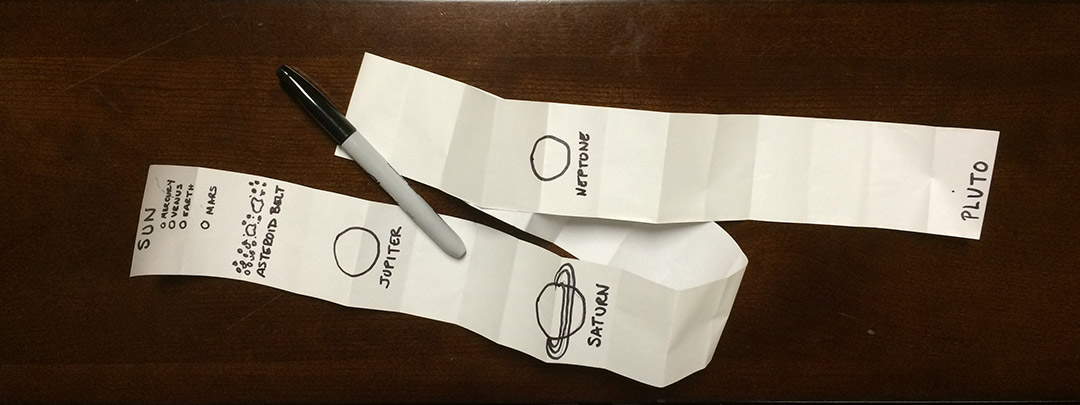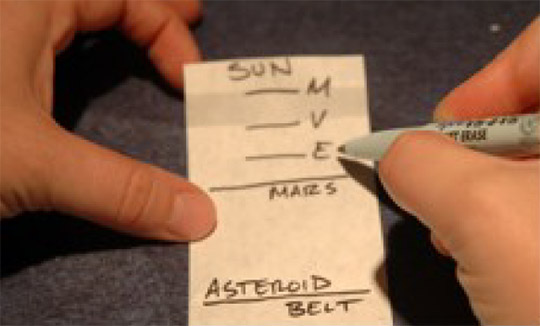Pocket Solar System
This activity will help you better understand the distances between the planets and their distances from the sun in our solar system. For convenience, you can also download this file with the link below.
How far apart are the objects in space? Let’s check out the distance between the planets with an easy activity.

Materials:
- Markers/Pens/Pencils
- Cash Register Tape
- Scissors

Procedure:
- Start with a length of register tape the span of the letter "V" made with your arms (~1m).
- Sun & Pluto (on the edges):
Draw just the very edge of the sun on one end of the tape and label it. Draw the smallest dot you can on the other end of the tape and label it Pluto. Even though Pluto has been reclassifed as a dwarf planet it serves as a useful reference point here. We can use it as the first example of such a dwarf planet ever found. Use cash register or adding machine tape for this activity. - Uranus (1/2):
Fold the tape in half, crease it, unfold and lay it flat. Which of the planets might be at this halfway point? Draw a circle about the size of a nickel and label it Uranus. - Saturn (1/4) and Neptune (3/4):
Fold the tape back in half, then in half again. Fractions: 1/4th and 3/4th. Unfold and lay flat. What planets do you think are at these points? Draw a circle a little bigger than a quarter on the 1/4th mark (closer to the Sun) and label it Saturn. You may even want to include Saturn's rings. Draw another nickel-sized circle on the 3/4th mark (closer to Pluto) and label it Neptune. - Jupiter (1/8):
Fold back into quarters, then in half one more time - eighths. Unfold and lay flat again. What planet do you think lies here? Draw the largest circle you can at the 1/8 mark (between the Sun and Saturn), and label it Jupiter. - Asteroid Belt (1/16):
We don't need to fold the whole thing up again. If you take a look, you've got the 4 gas giants and Pluto all on there in the outer solar system. For the terrestrial (rocky) planets, you only need 1/2 of the first 1/8th! That's the inner 1/16th of your solar system. Fold the Sun end of the solar system in to meet Jupiter at the 1/16th spot. A planet does not go on the new crease, but the asteroid belt does. - Earth (inside 1/32), Mars (outside 1/32):
Now things start getting a little crowded and folding is tough to get precise distances. Fold the first 1/16th in half by folding the Sun end of the solar system in to the crease at the 1/32nd spot, where the asteroid belt is. Draw a small circle about the size of a Nerds candy for Earth just inside this fold (closer to the Sun) and a slightly smaller circle for Mars just outside the fold (closer to the Asteroid Belt) and label them. - Mercury & Venus (between Earth & Sun):
Between the Sun and Earth are two more planets, Mercury, closer to the Sun and Venus, closer to Earth. As best you can, evenly space these planets out in the space you have left between the Sun and Earth. Draw a small circle a little smaller than Mars for Mercury and about the same size as Earth for Venus. Be sure to label these planets.
Be sure to put your name on your tape and fold it up to put it in your pocket. But before you put it away, here are some questions to get you thinking about what you can learn from building this model.
- Are there any surprises? Look how empty the outer solar system is: there is a reason they call it space! And how crowded the inner solar system is (relatively speaking). Even though it looks crowded in this model, are our closest planets very close? What's the farthest distance humans have ever travelled away from Earth? The moon!
- Do you know anything about the physical properties of the ones that are spread out versus the ones that are crowded in close to the Sun? All the inner ones are small and rocky and the outer ones are gassy giants (except small, icy Pluto).
- Given this spacing, why do you think little, rocky Venus can outshine giant Jupiter in the night sky? Both are covered with highly reflective clouds, and although it is much smaller, Venus is also much, much closer.
- Does anyone know where the Eris, the largest dwarf planet would go on this model? At 97 A.U., it would more than double the size of the model. Pluto is on average 40 A.U. [A.U. stands for Astronomical Unit, roughly the mean distance from the Earth to the Sun. 1 AU = 149,597,870.691 kilometers, or about 93 million miles.]
- On this scale (1 m = 40 A.U.) where would the nearest star be? After some guesses you could bring out your pocket calculator to use in getting how far away the star would be. This allows you to talk about how far is a light year and do the calculations. The next nearest star on this scale is about 7 km (4.2 miles) away. They could then take out a local map to see what is that far away from the class. You'd need a lot more register tape!
- [Calculations: A light year, the distance light travels in one year, is about 63,240 A.U. (about 9,460,000,000,000 km). The nearest star is Proxima Centauri (visible from the Southern Hemisphere), at 4.2 light years. So, 4.2 l.y. x 63,240 A.U./l.y. x 1 m/ 40 A.U. = 6640.2 m = about 7 km.]
- You can keep this model to explain the vast distances in the solar system to your friends and family.